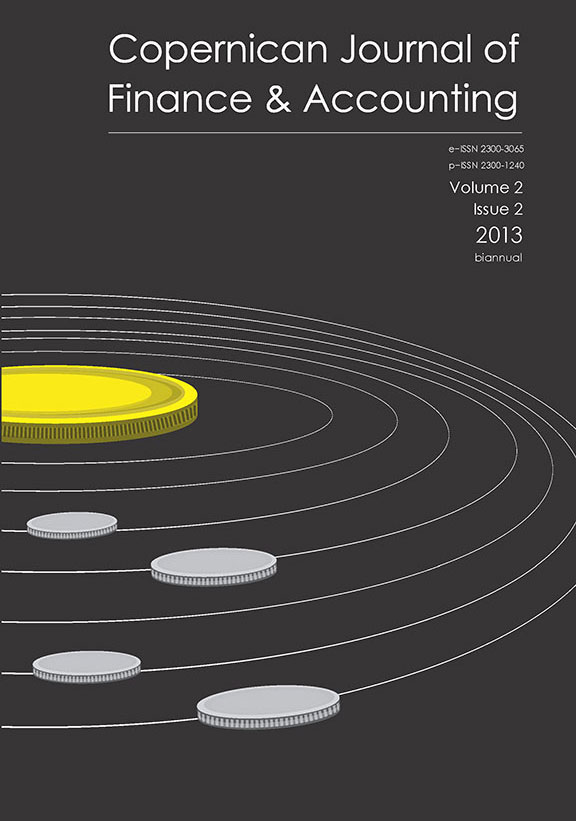Book-keeping in Mesopotamia in the Third and Second Millennium BC
DOI:
https://doi.org/10.12775/CJFA.2013.022Keywords
Mesopotamia, book-keeping, clay tablets, cuneinform texts, balancing, bala taxAbstract
The recent, twentieth-century research on the history of the development of book-keeping indicates that it originated with the development of the Sumerian civilization in the third millennium BC. The necessity to control the property of the temple and of the palace, which was entrusted to breeders, farmers, merchants or craftsmen contributed to the creation of a very sophisticated method of documenting the events concerning these possessions. The article aims at identifying the reasons behind the emergence of book-keeping in Mesopotamia, discusses its instances in the form of inscriptions on clay tablets and analyzes examples of settlements concerning entrusted property, which, balancing debts and liabilities, have the characteristics of book-keeping. These settlements are primarily characterized by a personal approach – the one to whom the property has been entrusted is on the debit side. It was already in this period that the balancing method was employed in the case of factory or ‘budget’ book-keeping in redistributing the bala tax, as it is illustrated with examples of settlements concerning cattle breeders, merchants and craftsmen. In this article I refer to such publications as the proceedings of periodic academic conferences (Oxford University, 1998; Columbia University, 1998, British Museum, 2000) on the economy of the ancient Middle East as well as Marek Stępień’s (Warsaw University) works concerning the issues of taxation in Sumerian times.
References
Bielicki M. (1969), Zapomniany świat Sumerów, PIW, Warszawa.
Carmona S., Ezzamel M. (2007), Accounting and accountability in ancient civilizations: Mesopotamia and ancient Egypt, “Accounting, Auditing & Accountability Journal”, vol. 20, no. 2, 177–209, doi: http://dx.doi.org/10.1108%2F09513570710740993.
Dobija M. (1996), Postępowe idee rachunkowości w cywilizacji sumeryjskiej, „Zeszyty Naukowe AE w Krakowie”, nr 467, 5–18.
E.M. (1994), Rachunkowość fabryki włókienniczej sprzed 4000 lat,
„Rachunkowość”, nr 5, 226–227 (tłumaczenie artykułu: Das Rechnungswesen im vorbabylonischen Sumer Mesopotamiens vor viertausend Jahren, insbesondere die perfekte Fabrikbuchaltung lines grossen Textilbertriebs, „Die Wirtschaftsprüfung”, No. 14/1993).
Englund R. K. (2004), Proto-Cuneifirm Account-Books and Journals, [w:] Creating Economic Order. Record-Keeping, Standardization, and the Development of Accounting in the Ancient Near East, M. Hudson, C. Wunsch (eds.), CDL Press, Bethesda, Meryland, 23–46
Hallo W. W. (2004), Bookkeeping in the 21st Century BCE, [w:] Creating Economic Order. Record-Keeping, Standardization, and the Development of Accounting in the Ancient Near East, M. Hudson, C. Wunsch (eds.), CDL Press, Bethesda, Meryland, 89–106
Jursa M. (2002), Prywatyzacja i zysk. Przedsiębiorcy a gospodarka instytucjonalna w Mezopotamii od 3 do 1 tysiąclecia przed Chr., Poznańskie Towarzystwo Przyjaciół Nauk, Poznań.
Kodeks Hammurabiego, tłum. Marek Stępień, http://www.zrodla.historyczne.prv.pl/ (dostęp: 21.12. 2012).
Kurek B. (2004), Rachunkowość jako stymulator rozwoju kultury, „Zeszyty Teoretyczne Rachunkowości”, t. 24 (80), 38–59.
Mieroop M. van de (2004), Accounting in Early Mesopotamia: Some Remarks, [w:] Creating Economic Order. Record-Keeping, Standardization, and the Development of Accounting in the Ancient Near East, M. Hudson, C. Wunsch (eds.), CDL Press, Bethesda, Meryland, 47–64
Mieroop M. van de (2012), Ukryta historia w tekstach klinowych, Wyd. Agade, Warszawa.
Saggs H. W. G. (1973), Wielkość i upadek Babilonu, PIW, Warszawa.
Schmandt-Besserat D. (2007), Jak powstało pismo, Wyd. Agade, Warszawa.
Sharlach T. M. (2004), Provincial Taxation and the Ur III State, “Cuneinform Monographs”, 26, Leiden–Boston.
Steinkeller P. (2003), Archival Practices at Babylonia in the Third Millennium, [w:] Ancient Archives and Archival Traditions. Concept of Record-Keeping in the Ancient World, M. Brosius (ed.), Oxford University Press, New York, 37–58
Steinkeller P. (1987), The Administrative and Economic Organization of the Ur III State: The Core and the Periphery, [w:] The Organization of Power: Aspect and Bureaucracy in the Ancient Near East, R. D. Biggs, Mc G. Gibson (eds.), “Studies in Ancient Oriental Civilization”, 46, Chicago, 19–47
Stępień M. (1996), Animal Husbandry in the Ancient Near East. A Prosopographic Study of Third-Millenium Umma, CDL Press, Bethesda, Maryland.
Stępień M. (2006), Ensi w czasach III dynastii Ur: aspekty ekonomiczne i administracyjne pozycji namiestnika prowincji w świetle archiwum z Ummy, Wyd. Uniwersytetu Warszawskiego, Warszawa.
Downloads
Published
How to Cite
Issue
Section
Stats
Number of views and downloads: 1149
Number of citations: 0



